Chapter 2.
IMPERATOR ANDRONICUS KOMNIN OF THE XII CENTURY - IT IS JESUS CHRIST DURING HIS PRESENCE IN TSAR-GRAD OF THE XII CENTURY.
29. THE LAST SUPPER, THE BETRAYAL OF JUDAS, IDENTIFICATION OF CHRIST, HIS ARREST AND PILATES’ JUDGEMENT IN THE BYZANTINE BIOGRAPHY OF ANDRONICUS I COMNENUS.
29.1. CHRONICLE OF ROBERT DE CLARI ‘THE CONQUEST OF CONSTANTINOPLE’
We will use here a well know work by Robert de Clari ‘The Conquest of Constantinople’ written by him allegedly in the early XIII century [117], p.81. In the book there is given a description of the famous Fourth Crusade and the seizure of Czar-Grad in 1204. The historians say: ’The chronicle ‘The Conquest of Constantinople’ by Robert de Clari, created in the early XIII century alongside the work of Geoffrey of Villehardouin by the same name belongs to a number of the SOURCES OF THE UTMOST IMPORTANCE on the history of the conquest of Constantinople by the knights-crusaders in 1203-1204’ [117], p.81.
Unlike Villehardouin, Robert de Clari begins his account a little bit earlier 1204 and in particular reports about the last events from the life of the emperor Andronicus which is absent from Villehardouin’s chronicle. This information turns out to be exceptionally important as they wonderfully prove the overlapping of Andronicus with Christ which we have discovered. Here it is worth noting that the testimonials reported to us by Robert de Clari most likely survived only on the pages of his Chronicle. The other secular Byzantine authors keep quiet about them or have simply forgotten.
We will say straight away that similar to Niketas Choniates, Robert de Clari’s attitude towards Andronicus Comnenus is strongly negative. And not just negative, but emotionally negative. It is evident that he is greatly concerned by any events associated with Andronicus, he is clearly not indifferent towards them. The contemporary commentators note: ‘the hostile perceptions of Andronicus I, saturating the Byzantine insights of Robert de Clari, is a repercussion of the values and perceptions which were WIDELY SPREAD IN THE WEST in the late XII – early XIII cc. with its source as basileus’ (Andronicus’ – Author) anti Latin policy’[117]. p.135, commentary 126.
29.2. THE LAST SUPPER AND CHRIST’S PRAYER IN THE GARDEN OF GETHSEMANE.
The Gospels tell us that before his arrest Christ and his disciples-apostles gathered in a secluded place where they had something to eat and to drink. This scene is well known in the Christian tradition as ‘The Last Supper’. It was depicted in various mediaeval icons and paintings. ‘NOW WHEN THE EVEN WAS COME, he sat down with the twelve. And as they did eat, he said, Verily I say unto you, that one of you shall betray me… And as they were eating, Jesus took bread, and blessed it, and broke it, and gave it to the disciples, and said, Take, eat; this is my body. And he took the cup, and gave thanks, and gave it to them, saying, Drink ye all of it; For this is my blood of the new testament… I will not drink henceforth of this fruit of the vine, until that day when I drink it new with you in my Father's kingdom’ (Matthew 26:20, 26:26-29).
According to the church tradition this scene was usually presented in the numerous Mediaeval paintings in the following way. At a long table in some secluded and rather cramped room there are sitting Christ and his twelve apostles. There is food and drink on the table. See for example A.Durer’s engraving in fig.2.65 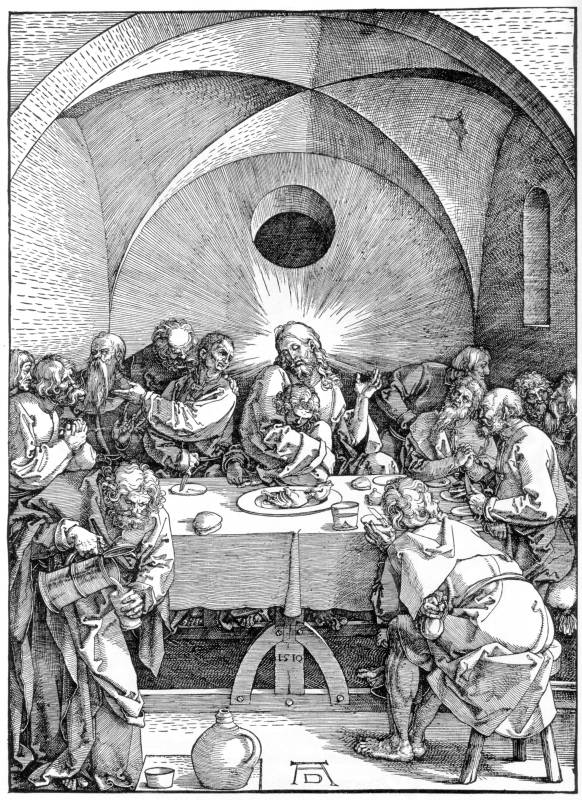 . It is considered that Christ and the apostles got together in secret from the others. Hence the name of their evening meeting – (‘The Last Supper’ in Russian is ‘The Secret Supper’ – Translator). The participants of the meeting are eating and drinking wine pouring it from jugs.
. It is considered that Christ and the apostles got together in secret from the others. Hence the name of their evening meeting – (‘The Last Supper’ in Russian is ‘The Secret Supper’ – Translator). The participants of the meeting are eating and drinking wine pouring it from jugs.
According to the Gospels following the Last Supper Christ with several of his apostles retire to the Garden of Gethsemane at night, where he prays God asking him: ‘O my Father, if it be possible, let this cup pass from me… except I drink it’ (Matthew 26:39, 26:42). Christ’s disciples who were accompanying him fell asleep despite the fact that Christ was waking them up several times and asked them to stay with him awake. That very night in a very short time Christ was arrested by the arriving soldiers.
Let us turn now to the Byzantine history as told by Robert de Clari, a well-known mediaeval author of the book ‘The Conquest of Constantinople’ [117]. Here is what Robert de Clari reports about the last day of Andronicus Comnenus being free, prior to his night arrest. Andronicus together with some of his attendants tried to flee to escape persecution, however his ship was washed ashore by the storm back to Czar-Grad. ‘And they looked and saw plainly that they were returned to Constantinople; therefore said they to Androm (By the way Robert de Clari calls Andronicus – Androm – Author): “Lord, we are dead men…” When Androm heard this he was so sore dismayed that he knew not what to do, and he said to his people, “Sirs, for God’s sake take us elsewhere, away from this place!” … And when they saw that they could not on any wise proceed on their way, they took Androm, the emperor, and BROUGHT HIM TO A TAVERN AND THEY HID HIM BEHIND THE WINE-BUTTS. The tavern-keeper and his wife REGARDED CLOSELY these people, and it was in their mind that they were of the people of the Emperor Androm’ [117], p.21-22.
Before us here is the scene of the Gospel Last Supper. Andronicus-Christ and several of his close attendants seclude themselves in a tavern, hiding from persecution. They spent there a long time as it is stressed that the owner of the tavern and his wife REGARDED CLOSELY (FOR A LONG TIME) the unknown visitors. We should think that Andronicus and his companions were resting and had something to eat and to drink in the tavern. Incidentally the reason, why there are some other people (presumably serving those who are having supper) besides Christ and his twelve apostles in some of the old depictions of the Gospel Last Supper, becomes clear. See for example fig.2.66 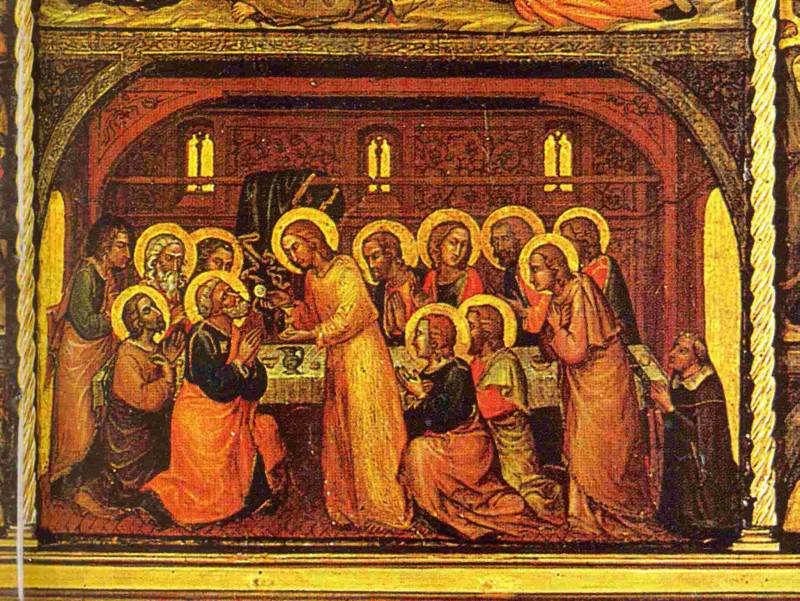 , fig.2.67
, fig.2.67 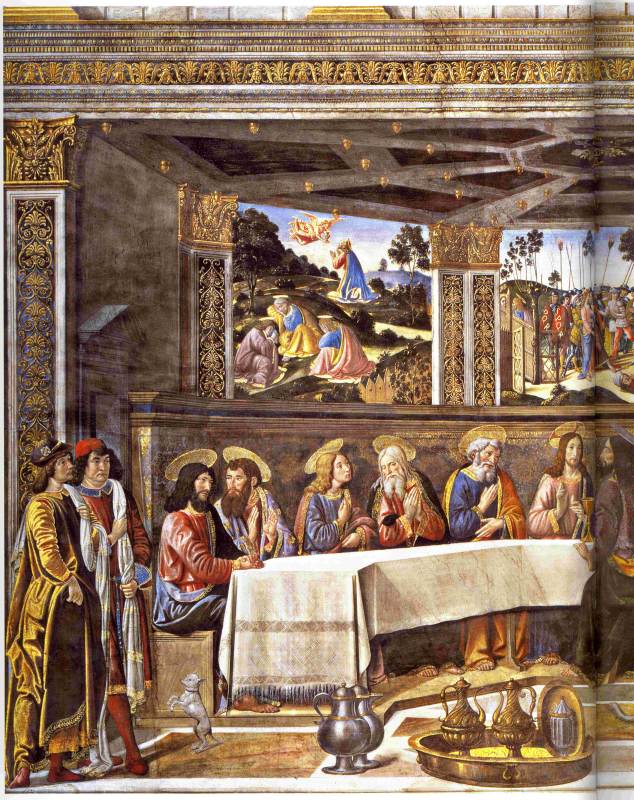 , fig.2.68
, fig.2.68 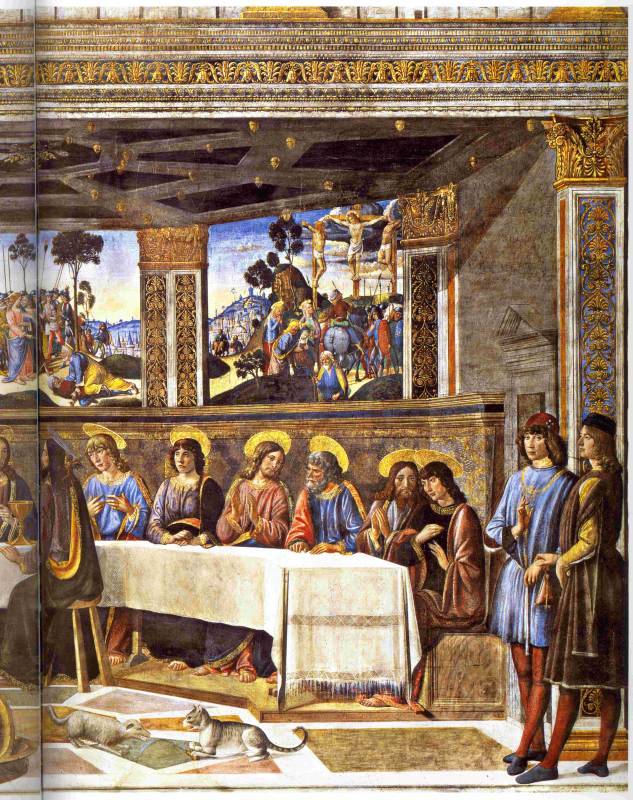 , fig.2.69
, fig.2.69  and fig.2.70
and fig.2.70 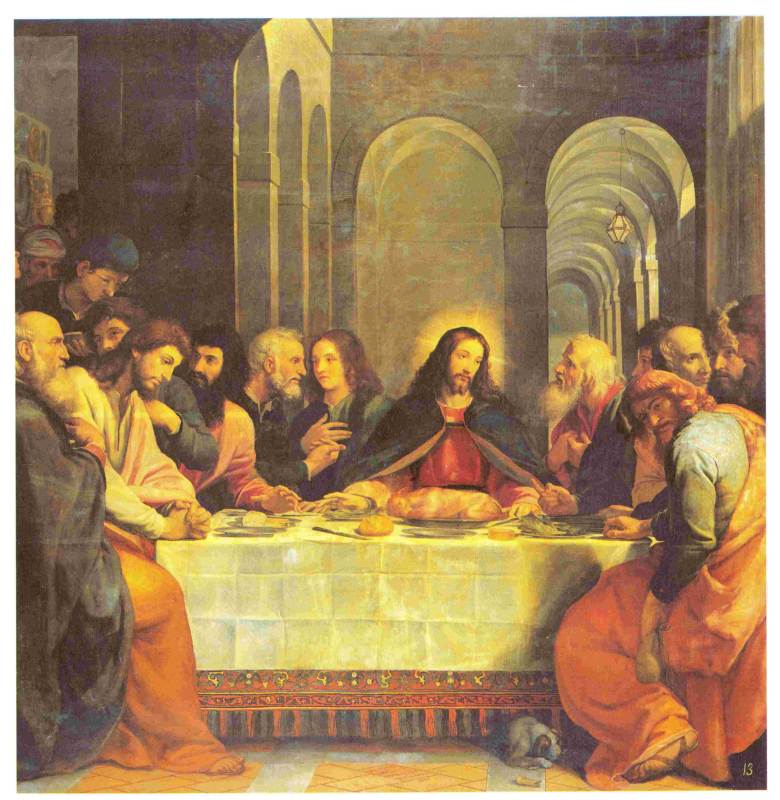 . Presumably for some time there survived a tradition which remembered that during the Last Supper in the room besides Christ and his 12 apostles there were also the owners of the tavern or their servants. Robert de Clari informs us that at the very least the tavern owner and his wife were present there.
. Presumably for some time there survived a tradition which remembered that during the Last Supper in the room besides Christ and his 12 apostles there were also the owners of the tavern or their servants. Robert de Clari informs us that at the very least the tavern owner and his wife were present there.
Above we have already suggested an idea that the expression ‘in Zebedee’s house’ most likely meant simply ‘in an establishment’, i.e. in a tavern, in a pub, in an inn or in a similar place. This is exactly what Robert de Clari says. He states that Andronicus’ ‘Last Supper’ took place in a TAVERN.
It is possible that in Robert de Clari’s narrative we also see a storyline of Christ’s prayer in the garden of Gethsemane. Andronicus having taken refuge from persecution is praying to God. Robert de Clari stresses, that the emperor was hiding behind the WINE-barrels [117], p.22. The Gospels also inform us that during the Last Supper they were drinking wine.
All of these events unfold in the atmosphere against the backdrop of the persecution and suffering of the emperor. According to the Gospels immediately following the Last Supper, when in the garden of Gethsemane Christ is asking God not to let him have the last cup of suffering: ‘ except I drink it’ (Matthew 26:42). In fig.2.7 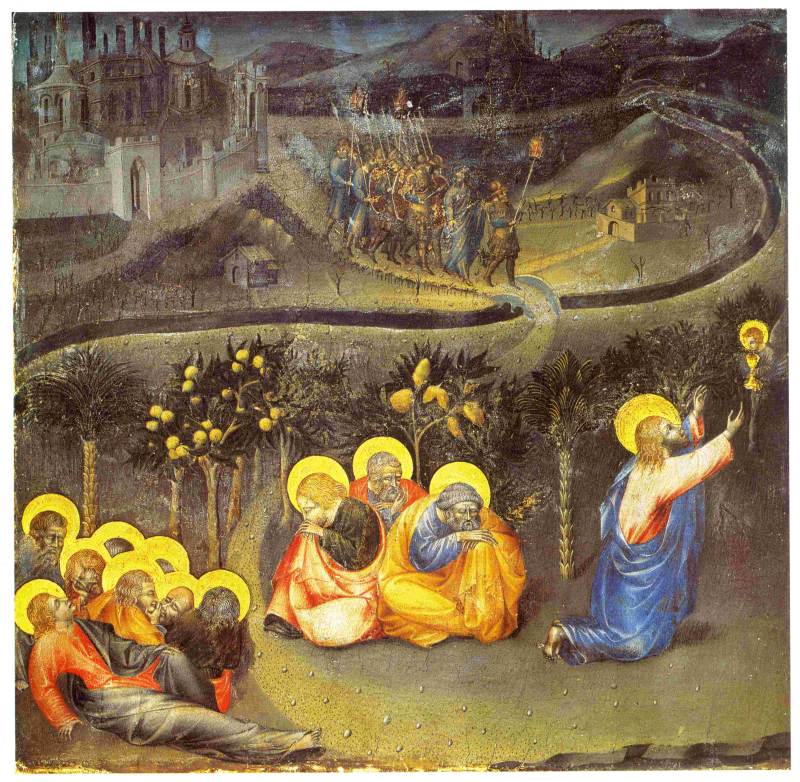 there is presented an old depiction of the scene in the garden of Gethsemane. The tired apostles fell asleep. The painting makes perfect sense as according to Robert de Clari, Andronicus’ companions were in fact very tired after the turbulent sailing, forced to come ashore and after their supper in the tavern, they naturally fell asleep. Probably Andronicus and his companions were praying for salvation in these last hours before their arrest. Clearly here Robert de Clari copied and edited some primary source, very close to the surviving Gospel versions.
there is presented an old depiction of the scene in the garden of Gethsemane. The tired apostles fell asleep. The painting makes perfect sense as according to Robert de Clari, Andronicus’ companions were in fact very tired after the turbulent sailing, forced to come ashore and after their supper in the tavern, they naturally fell asleep. Probably Andronicus and his companions were praying for salvation in these last hours before their arrest. Clearly here Robert de Clari copied and edited some primary source, very close to the surviving Gospel versions.
In fig.2.71  there is presented a photograph of a cup from which Christ drank during the Last Supper. It is a richly adorned coral goblet, at present kept in Valencia (Spain), the city which until the XVII century was a residency of the patriarch of Antioch. The throne of Antioch is considered to be one of the main thrones in the Christian world that is why it is quite possible that before us is Christ’s true cup. We would like to note, that the cup is far from being ordinary. It is a rather expensive item. Hardly a goblet that a commoner would drink from.
there is presented a photograph of a cup from which Christ drank during the Last Supper. It is a richly adorned coral goblet, at present kept in Valencia (Spain), the city which until the XVII century was a residency of the patriarch of Antioch. The throne of Antioch is considered to be one of the main thrones in the Christian world that is why it is quite possible that before us is Christ’s true cup. We would like to note, that the cup is far from being ordinary. It is a rather expensive item. Hardly a goblet that a commoner would drink from.
29.3. THE IDENTIFICATION OF CHRIST BY TRAITOR JUDAS.
The Gospels say that Judas identifies Christ amongst a group of people. He comes up to Christ and kisses him.
We see the very same scene in Robert de Clari’s account of Andronicus’ fate. After the owner of the tavern and his wife ‘closely regarded these people for a long time’ they suspected that in front of them were the emperor’s companions. ‘At last, by chance, THE TAVERN-KEEPER’S WIFE went about amongst the wine-butts (wine barrels - Author) for to see that they were stopped tight, and looking round about her, lo, she espied Andronicus sitting behind the wine-butts in all his imperial vestments; and she knew him right well. So back came she to her lord, and she said to him, “Lord, Andronicus, the emperor, is hidden here within!” [117], p.22.
Robert de Clari’s identification-betrayal of Androm is carried out by a woman. Although, in a moment there will also appear a male traitor. In the Gospels the traitor is a man, Apostle Judas. In the other duplicate of these events, i.e. in the story of Andrey Bogolyubsky the role of Judas is carried out by a couple: a woman (Andrey’s wife) and a man. See the details in the following chapter 3.
Incidentally in the Gospels there apparently also survived a trace of that fact that the identification-betrayal of Christ and his companions was carried out by a woman. We refer to the identification of Peter the Apostle, however after Christ’s arrest. ’Now Peter sat outside in the courtyard. AND A SERVANT GIRL CAME TO HIM, SAYING, ‘YOU ALSO WERE WITH JESUS OF GALILEE’. But he denied it before them all, saying, “I do not know what you are saying.” (Matthew 26:69-70). It is possible that the ‘servant girl’ mentioned in the Gospels is the very wife of the tavern owner who identified the emperor and his companions.
29.4. JUDAS GOES TO CHRIST’S ENEMIES AND BETRAYS HIM, INFORMING THEM OF HIS WHEREABOUTS.
According to the Gospels Apostle Judas decided to betray Christ and personally goes to his enemies offering to capture Jesus.
Robert de Clari conveys the same information. As soon as the tavern owner’s wife identified emperor Andronicus, the tavern owner immediately sends a messenger to the emperor’s enemies to denounce him. We quote: ‘When the tavern-keeper heard this HE SENT A MESSENGER TO A CERTAIN NOBLEMAN who dwelt hard by in a great palace, whose father Andronicus had put to death; moreover, he had ravished the wife of this nobleman’ [117], p.22. The last phrase could be a tribute of hatred towards Andronicus, which was impressed onto the population and the representatives of the ‘Latin’ party in Czar-Grad. This way or another, but we see that the denunciation was forwarded to the ENEMY OF ANDRONICUS which corresponds well with the Gospels’ description: Judas went to the enemies of Jesus.
We will continue quoting: ‘WHEN THE MESSENGER (i.e. the duplicate of the Gospel Judas – Author) WAS COME THITHER HE SAID TO THIS NOBLEMAN THAT ANDROM WAS HIDING IN THE HOUSE OF THE TAVERN-KEEPER AND SAID HIS NAME’ [117], p.22.
29.5. CHRIST’S ARREST.
According to the Gospels after Judas’ denunciation the high priests immediately send a soldiers unit to capture Jesus. ‘Lo, Judas … came, and with him a great multitude with swords and staves, from the chief priests and elders of the people (Matthew 26:47).
Robert de Clari says practically the same: ‘And the nobleman was rejoiced thereat (when he heard that Androm was in the house of those tavern keeper); AND HE TOOK CERTAIN OF HIS PEOPLE AND HE WENT TO THE TAVERN-KEEPER’S HOUSE AND HE SEIZED ANDROM AND BROUGHT HIM TO HIS OWN PALACE’ [117], p.22.
29.6. JUDAS’ THIRTY PIECES OF SILVER.
The Gospels say that Judas received for his betrayal THIRTY PIECES OF SILVER (Matthew 26:15). The trace of this fact survived in the accounts of Nicetas Choniates. Apparently after his arrest Andronicus’ palace was pillaged. ‘The enormous wealth accumulated by the Komnenoi was simply pillaged by the mob. The historian even presents ‘the exact’ data about the amount of the gold, silver and copper coins, and also the silver bullions expropriated by the plebs: 12 pieces кентариев of gold, 30 – OF SILVER and 200 of copper’ [117], p.137, commentary 144. It is possible that the thirty pieces кентариев
of silver stolen from Andronicus’ palace reflected in the Gospels as Judas’ ‘thirty pieces of silver’.
29.7. PILATE’S JUDGEMENT OF JESUS.
According to the Gospels the arrested Christ was brought to Pilates who was called ‘the governor’. We quote: ‘And Jesus stood BEFORE THE GOVERNOR: and the governor asked him, saying, Art thou the King of the Jews? And Jesus said unto him, Thou sayest. And when he was accused of the chief priests and elders, HE ANSWERED NOTHING. Then said Pilate unto him, Hearest thou not how many things they witness against thee? And he answered him to never a word; insomuch that the governor marvelled greatly’ (Matthew 27:11-14).
Robert de Clari gives us an account of the ‘governor’s judgement’ using literally the same words: ‘And when the morrow came, early in the morning, the nobleman took Androm and LED HIM AWAY TO THE ROYAL PALACE INTO THE PRESENCE OF THE EMPEROR KIRSAC (i.e. to the Kir Isaac, king (czar) Isaac – Author). When Isaac saw him he said to him, “Androm, wherefore hast thou in such fashion betrayed thy lord, the Emperor Manuel…” [117], p.22. Then Robert de Clari lists the alleged crimes of Andronicus, which the governor Isaac accuses him of. We have already said that Robert de Clari has a negative view on Andronicus and avails himself at every opportunity to allege every conceivable ‘ill action’ against him.
Further: ‘And Androm answered him, “Hold thy peace!” quoth he “FOR I WOULD NOT DEIGN TO ANSWER THEE! "’ [117], p.22.
Thus we see a good correspondence between the Gospel story and Andronicus’ story.
29.8. PILATES WASHES HIS HANDS AND FOLLOWING THE PEOPLE’S DEMAND GIVES CHRIST OVER FOR EXECUTION.
The Gospels say: ’And the governor said, Why, what evil hath he done? But they cried out the more, saying, Let him be crucified. When Pilate saw that he could prevail nothing, but that rather a tumult was made, he took water, and washed his hands before the multitude, saying, I am innocent of the blood of this just person: see ye to it. Then answered all the people, and said, His blood be on us, and on our children. Then … he had scourged Jesus, he delivered him to be crucified. (Matthew 27:23-26).
Robert de Clari describes virtually the same events: ‘When the Emperor Kirsac heard that HE (Andronicus – Author) WOULD NOT DEIGN TO ANSWER HIM, HE SUMMONED MANY OF THE MEN OF THE CITY TO COME INTO HIS PRESENCE. And when they were in his presence, the emperor said to them, “Sirs, behold, here is Androm, who hath done so much evil both to you and to others (here, as we can see, again can be heard the condemning propaganda pressure from Robert de Clari – Author). I MYSELF COULD, ME SEEMETH, IN NO WISE DO SUCH JUSTICE TO HIM as ye all would desire; BUT I RELEASE HIM TO YOU, TO DO WITH HIM WHAT YE WILL’. THEN WERE THE MEN OF THE CITY RIGHT GLAD AND THEY TOOK HIM’. [117], p.22.
Further Robert de Clari describes the sufferings of Andronicus and his martyr's death. We will come back to this story in more detail a little bit later.
30. ISAAC ANGELOS DRAGS ANDRONICUS BY THE IRON CHAIN ON HIS NECK.
Nicetas Choniates includes in his, ‘Historia’ the following story which might seem not particularly coherent at first glance. Allegedly when Emperor Manuel was still alive, Andronicus who was in exile decided to ask to be pardoned. Let us present nearly the entire story here: ‘The emperor agreed … and in some time Andronicus appeared. Being a cunning and capable of any clownish trickery, HE PUT ON HIS NECK A HEAVY IRON CHAIN, which reached his feet and concealed it under his cloak… Being permitted to appear before the emperor, he, as soon as the emperor saw him, immediately stretched on the floor in full length of his huge height, showed off his chain and with tears in his eyes passionately and movingly asked forgiveness for everything he had ever insulted the emperor with. The emperor, being astonished by this sight (fantasizes Choniates, as such actions look rather weird and are not motivated by anything – Author), shed a tear himself and ordered Andronicus to be picked up from the floor, but he assured the emperor that he would not get up until SOMEONE AMONG THOSE PRESENT ON THE EMPEROR’S ORDER WOULD DRAG HIM BY THE CHAIN OVER THE STEPS OF THE THRONE AND PROSTRATE HIM BEFORE THE FOOT OF EMPEROR’S SEAT. Everything was done as Andronicus pleaded. It was carried out by Isaac Angelos, who later on brought Andronicus down – the event which is difficult not to be surprised by and which hardly could be explain by a meaningless turn of events or by a mere chance’ [140], p.241-242.
The related story sounds so strange, that Nicetas Choniates himself cannot help it, but comment on it in confusion. The matter is that if we were told that this happened after Andronicus was already captured and taken to the execution, than everything would fall into place. But Nicetas Choniates puts it in a completely different place, i.e. it refers to the time when though the relationship between Andronicus and Manuel were complex, they were not too bad. And anyway at that point no one asked for such a humiliation from Andronicus. Choniates himself probably realised that this plot is ‘placed incorrectly’ and that’s why talks confusingly about the impossibility of a random coincidence.
But now we understand what in fact the question is about here. Let’s remember the Gospel story about Christ being seized by the soldiers. See above the quotes from the book ‘Passion of Christ’. There we are given a detailed account of the iron chain which was fastened around Christ’s neck. It tells us how he was dragged by the chain. See fig.2.72 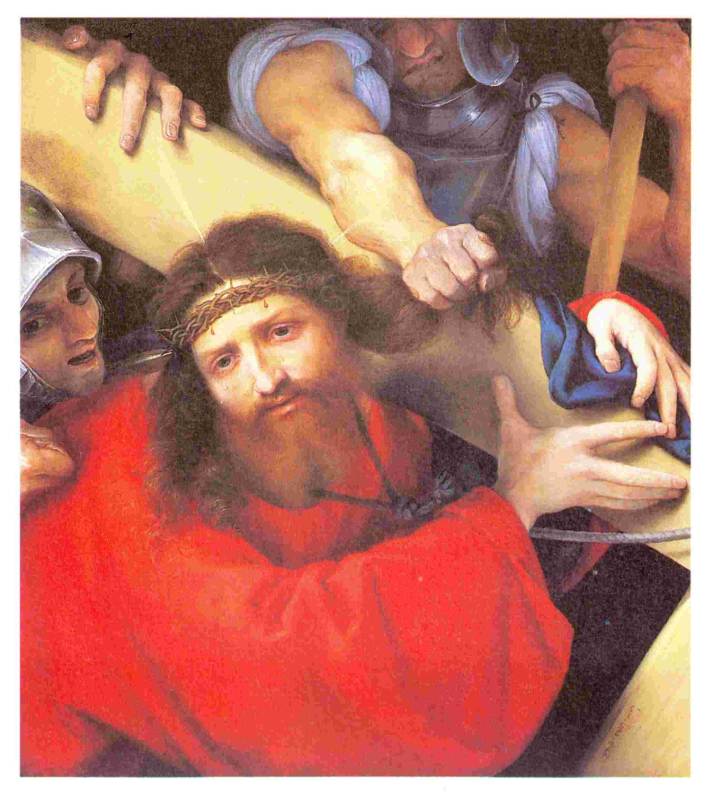 and fig. 2.73
and fig. 2.73 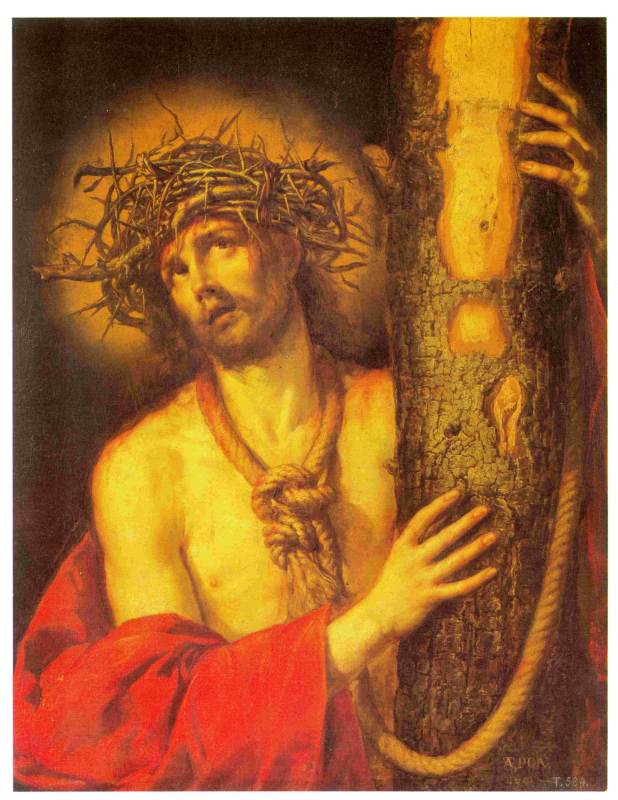 . Both stories – from the Gospels and by Nicetas Choniates are strikingly similar. Here we can see as the same event could sometimes be interpreted in a different way on the pages of the various chronicles. In this case the Gospel account is much more realistic. In regards to the Nicetas Choniates’ story – in front of us there is clearly blurred and distorted description of events. Nevertheless, the underlying motif, i.e. that Christ-Andronicus was dragged by a chain around his neck (on the ground or over the steps) was represented accurately.
. Both stories – from the Gospels and by Nicetas Choniates are strikingly similar. Here we can see as the same event could sometimes be interpreted in a different way on the pages of the various chronicles. In this case the Gospel account is much more realistic. In regards to the Nicetas Choniates’ story – in front of us there is clearly blurred and distorted description of events. Nevertheless, the underlying motif, i.e. that Christ-Andronicus was dragged by a chain around his neck (on the ground or over the steps) was represented accurately.
However, the chain on Andronicus’ neck was mentioned by Choniates once more and this time in ‘its right place’. Namely when describing the arrest of Andronicus. When the deposed Andronicus was ceased ‘he was thrown into a prison called Anemas, placed around his proud neck TWO HEAVY CHAINS WHICH ARE USED WITH IRON DOG COLLARS TO INCARCERATE LIONS and clapped his feet in irons. When IN THIS WAY they brought him and presented him in front of emperor Isaac, he was showered with insults, stricken on his face, cuffed and kicked’ [140], p.356-357.
Clearly before us is a brief summary of the same Gospel plot: Christ with the iron chain around his neck is dragged to the trial.
31. THE GOSPEL COURTYARD OF ANNAS THE HIGH PRIEST AND THE BYZANTINE PRISON ANEMAS.
According to the Gospels after being captured Christ was taken to the court yard of the Annas the high priest [127], p. 63. See above. According to Nicetas Choniates as soon as Andronicus was captured he was put to a prison called ANEMAS [140], p. 356. It seems that here ANNAS and ANEMAS is the same word. In one case they are speaking about a court yard of Annas and the other – about a prison Anemas. We should point out, that the letters H (N in Russian) and M in the old texts could have been mixed up easily due to the fact that for example both of them were sometimes denoted by the same symbol – a squiggly line. See CHRON5, Appendix (Annex) 2 and our book ‘Imperia’ (The Empire – translator). Once again we can see how on the pages of different chronicles the same word acquires slightly different forms and was interpreted in different ways. One scribe perceived it as the name of the high priest, the other – as the name of a prison.
32. ANDRONICUS’ BLINDED EYE AND CHRIST’S DAMAGED EYE ON THE SHROUD.
According to Choniates’ writing, prior to his execution they PUT OUT THE LEFT EYE OF Andronicus. ‘A few days later they poked out his left eye, put him on a mangy camel and triumphantly lead him around the square’ [140], p.357. There is nothing said about it in the Gospels, but it can be seen in the Shroud that one of Christ’s eyes was damaged and most likely, poked out, see above. This factor drew the attention of various scholars. In the photograph of the Shroud you can very well see a large vertical wound across the right eye see fig. 1.17 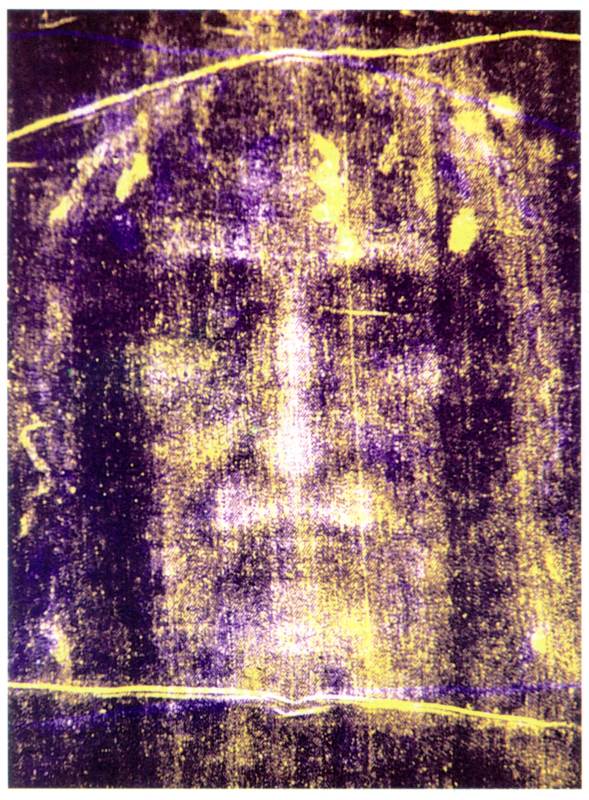 . Choniates writes about the left eye, but not about the right eye, but we should not forget about the fact, that Choniates’ narration is by no means an original. As we have seen it is some kind of compilation of the old sources made by a more recent editor. Besides, the documents themselves apparently also appeared as a result of multiple re-writes. As we understand it now the story of Christ was indeed very ancient. The twelfth century is deep antiquity according to the new chronology. We cannot expect the complete matching in the accounts in every detail. Nevertheless, the fundamental aspects of the events, as we are finding out, survived quite well. In this case – the blinded eye.
. Choniates writes about the left eye, but not about the right eye, but we should not forget about the fact, that Choniates’ narration is by no means an original. As we have seen it is some kind of compilation of the old sources made by a more recent editor. Besides, the documents themselves apparently also appeared as a result of multiple re-writes. As we understand it now the story of Christ was indeed very ancient. The twelfth century is deep antiquity according to the new chronology. We cannot expect the complete matching in the accounts in every detail. Nevertheless, the fundamental aspects of the events, as we are finding out, survived quite well. In this case – the blinded eye.
Let us also remember that in Choniates’ version Andronicus was compared to the CYCLOPS [140], p.279. To remind you – Cyclops are the ‘GIANTS WITH ONE EYE in their forehead, they are noted for remarkable strength’ [154].Besides, the cyclopes ‘belong to the MOST ANCIENT GENERATION OF GODS’ [95], v.1, p.649.
There emerges an impression, that Choniates calls Andronicus CYCLOPES by no means accidentally. Most likely the mythological Cyclopes is Christ, whom before his death was blinded in one eye. Christ was tall. Subsequently rumour built upon this fact created a mighty one eyed giant – Cyclopes. In fig.2.74  , fig.2.75
, fig.2.75 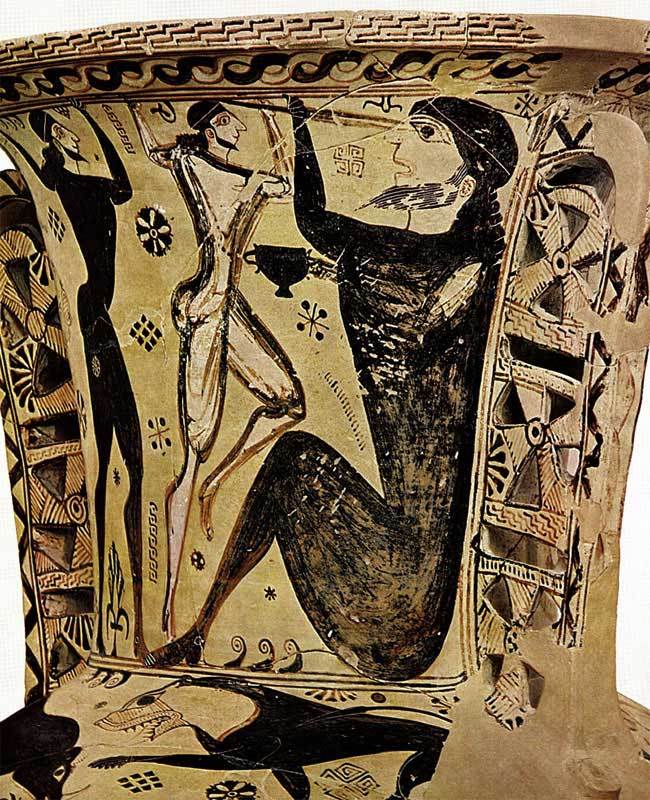 and fig.2.76
and fig.2.76 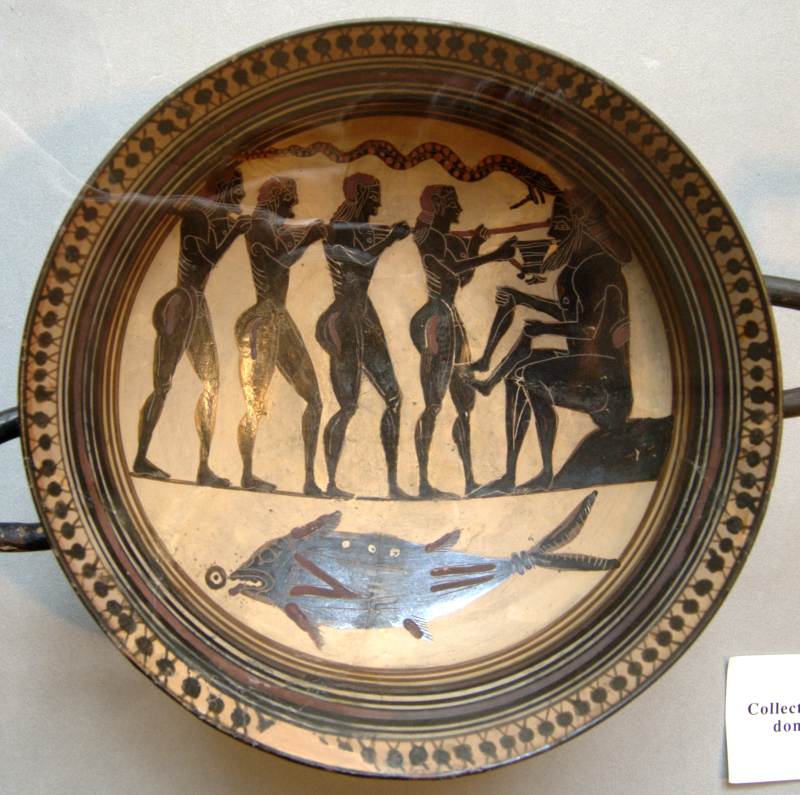 are shown the pictures of the ‘ancient’ Greek amphorae – the blinding of Cyclopes Polyphemus.
are shown the pictures of the ‘ancient’ Greek amphorae – the blinding of Cyclopes Polyphemus.